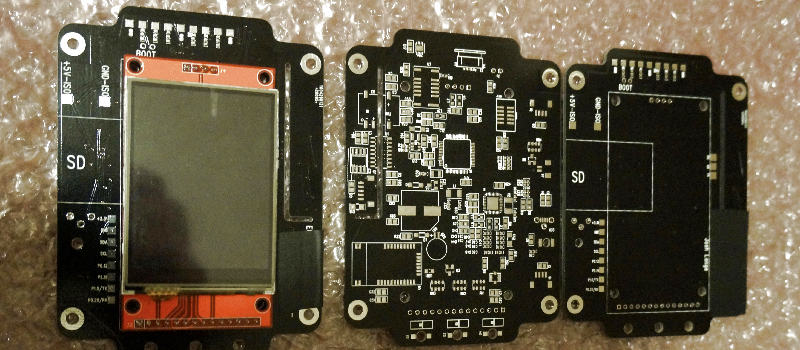A few years ago, thermal imaging sensors – cameras that could see heat – became very cheap. FLIR was going all-in with their Lepton module, and there were a number of clip-on cellphone accessories that gave the computer in your pocket the ability to see infrared.
Fast forward a few years, and you can still buy a thermal imaging sensor for your cellphone, and it still costs about the same as it did in 2013. For his Hackaday Prize project, [Josh] is building a more modern lower cost thermal imaging camera. It won’t have the resolution of the fancy $1000 FLIR unit, but it will be very inexpensive with a BOM cost of about $50.
[Josh] is building his low-cost thermal camera around Panasonic’s Grid-EYE module. This thermopile array contains 64 individual infrared sensors, giving this ‘camera’ a resolution of 8×8 pixels. That’s nothing compared to the thousands of pixels found in devices using the FLIR Lepton, but the Grid-EYE is very cheap.
Right now, [Josh]’s build is using an ARM Cortex M0+ and a cheap touch screen LCD he picked up from AliExpress. There’s an optional component to this build in the form of a visible light camera, giving [Josh] the ability to overlay thermal sensor data over a visible light image, just like the fancier, more expensive units.
With a total BOM cost of $44.50, [Josh]’s build is easy on the pocketbook, but still good enough to get some useful information. It’s a great build, and a great entry for The Hackaday Prize.




















It’s sad that it only goes up to 212F
“…I’ve gotten the GridEYE sensor working on my prototype board. I’ve implemented a simple linear mapping of -25 – 100 degrees = 100% blue to 100% red…”
212°F/100°C is only a limitation on the first software version for testing. It is likely easy to change the set ranges.
Scratch that.
You are very right; 212 seems to be the limit for this line of sensors.
Love what your doing! Thanks for sharing the knowledge..
Stupid import restrictions, I was working on a similar project and had boards made up for it when I discovered that digikey/mouser refuses to sell these sensors to Australia :(
That sucks. Could you bounce them around through another country first without breaking the law?
I don’t understand some types of trade restrictions. Banning the importation of wildlife, certain foods, dangerous chemicals makes sense. Banning PCBs does not to me.
I looked it up and found very little info; anyone know the reason?
Lead? RoHS regs?
“banning PCBs” or sensors as the case may be.
It most probably comes under the “dual use” stuff, somebody could use this thing to build a bomb or missile or something. The fact that I can just go to my local tool shop (also in Australia) and buy a FLIR brand FLIR is totally lost on them. Its just harming the american distributors to no real advantage.
IE from a major australian distributor
http://au.element14.com/webapp/wcs/stores/servlet/Search?pageSize=25&st=grid-eye&catalogId=15001&categoryId=800000000363&langId=43&storeId=10184
Dudeson up there, try E14, they are local and have a pretty decent range of stuff.
I wonder whether they can really be used for evil purposes. For example, a missile. I think they are way to slow to acquire lock on an aircraft. They even have 10s startup time. Useless for this purpose.
At export restricted 9fps, likely not. In full 30fps, maybe. 10s is kind of fast in this regard, because IIRC, early shoulder fired missiles required even longer chilldown.
Try E14
http://au.element14.com/webapp/wcs/stores/servlet/Search?pageSize=25&st=grid-eye&catalogId=15001&categoryId=800000000363&langId=43&storeId=10184
Huh, there you go. Worth a shot, thanks for your help.
Since a few people seemed to ask why, i’m piggybacking on the root comment.
The likely restriction to FLIR cores is ITAR, which is a US specific restriction on exporting (among other things) technology new enough and related to arms.
I could export Gen 0 night vision all i want, but I would need to do a lot of paperwork to possibly export gen 3 or 3+, and without the paperwork it would be an ITAR violation to even let a visitor from another country here in the us with me look through any restricted device.
It’s pretty much to make sure nobody other than allies they want get the highest tech stuff, even though most of it is on the open US market. They just don’t want them sent out of country pretty much except to certain places and people.
Nice work!
Too bad of the export regulations :(
Very cool. I want a clip-on thing for my glasses for augmented reality/night vision :D
Thanks for covering my project! I haven’t been able to work on it for a while, but I hope to have some more updates within the next few weeks.
I have been thinking about putting together a kit version of this once it’s done, but as several people have pointed out, the export restrictions on the sensor might make it difficult. If anyone has more insight into the legalities of reselling these sensors, I’d be interested to hear it.
At the price of some gold plated mirrors, a bit of math and time, the resolution can be made as good as you’d like. The jargon for this is “compressive sensing”. It uses ideas from wavelet theory to reduce the spatial sampling required. TANISTAFL though, you need to sample more times. The math is non-trivial, but the application is very simple. GLPK will solve the problem quite easily once you know how to set up the equations.
http://www.ece.rice.edu/~duarte/images/csCamera-SPMag-web.pdf
“more modern”
“8 by 8 pixels”
Yeah OK, it’s 2016 and 8×8 is more like 1930.